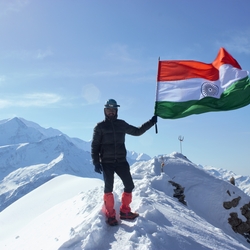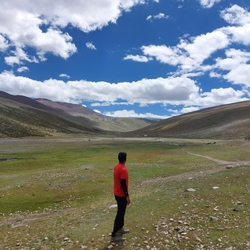Two treks located in the same region, the Kanchenjunga National Park, and yet so different from one another. Goechala and Sandakphu are trails that take you closer to Mt.Kanchenjunga, the third highest mountain in the world, and offer some of the best views of the Himalayas from Sikkim. However, they are quite different from each other in various aspects. If you are looking to trek in Sikkim and get a glimpse of the mighty Kanchenjunga, you might stumble on these two routes.
In this article, we draw a comparison between Goechala and Sandakphu to see what they have to offer and what would best fit your next Himalayan adventure!

Difficulty
Goechala and Sandakphu are miles apart in terms of their difficulty rating.
Sandakphu is rated Level 2 on the BRS (Bikat Rating Scale) which means it’s an easy beginner trek that can be attempted without much prior trekking experience. However, this trek spans over 7 days and covers a total distance of 81 kms. This is by no means a short distance and requires consistently covering long distances on each day. However, Sandakphu has the comfort of sleeping in warm beds and waking up well rested for the next day which makes this trek a lot more easier and comfortable.
Goechala is rated Level 5 on the BRS which indicates that it is a difficult trek and requires you to have prior trekking experience from a trek that is rated Level 4. Goechala is a challenging trail and requires considerable levels of fitness and endurance. The trek spans over 10 days and covers a total distance of 61 kms. While the distance might be 20 kms shorter than Sandakphu, it is more strenuous and difficult to complete.

Peaks Visible
Don’t get misled by the easy rating of Sandakphu. The trail still takes you to a maximum altitude of 3627 M and offers views of some of the highest mountains in the world. From the peak of Sandakhpu, we can see Mount Everest, Kanchenjunga, Lhotse and Makalu! These are some of the most prominent 8000ers you can spot from India and being able to spot them all at once is extremely rare!
The Goechala trek takes you all the way to the base of Mt.Kanchenjunga! If that’s not good enough, the enormous pass offers views of 12 towering peaks that are surely the best highlight of the trek. Talung, Rathong, Simvo and Pandim are some of the peaks that make for a dramatic landscape with Kanchenjunga stealing the show in all her grandiosity and might.
While you can still see Kanchenjunga from Sandakphu, the Goechala trail takes you right to its base leaving you in awe of the mountain and processing just how close to it you really are.
Terrain and Seasons
While Sandakphu is an easy trek, it does have its fair bit of challenges in the form of a few steep ascents, slippery descents, long distances and unpredictable weather. A majority of the route takes us through thick forests and dirt trails that leave us at a quaint village at the end of the day. A few days into the trek we also encounter bushy patches here and there. The descent on the last day involves a walk on a bed of leaves which can be slippery, particularly if it has been raining. Sandakphu is accessible in both winters and summers, transforming its landscape from one season to the next.
The challenging trail of Goechala offers varying terrain throughout with steep ascents and descents. The first two days take you through thick forests and as you move up, you leave the treeline behind to enter into drier mountainous terrain. The forests are often infested with leeches which make the climb more challenging than it already is. The dry rocky terrain from Dzongri tests your endurance and demands proper acclimatization to keep moving forward. In winters, the trail is covered in snow and the entire landscape is painted white. This trek makes for a great choice for a winter trek for experienced trekkers looking for a rewarding challenge.
Flora and Fauna
Thick bamboo, Magnolia, Oak and Rhododendrons are a common sight on the Sandakphu trek. Sandakphu is also known as the ‘mountain of poisonous plants’ owing to its heavy concentration of Himalayan Cobra Lilies. Red Panda, Barking Deer, Leopard Cat and Himalayan Black Bear are frequently seen in the region. Birds like Blood Pheasants, Parrotbills and Old World Babblers are also found here.
Juniper, Silver Oak and Rhododendrons dominate the forests on the trail of Goechala. The trees get fewer in number and completely fade out as we make our way higher into the mountains. Similar to Sandakphu, Himalayan Black Bear, Red Panda and Barking Deers can be spotted on a lucky day.

Both Sandakphu and Goechala make for excellent treks in Sikkim with staggering views of massive Himalayan ranges. While Sandakphu is accessible to both beginners and experienced trekkers, Goechala remains accessible only to trekkers with prior experience in the mountains. We hope this information helps you choose between the two treks for the upcoming winter season!






